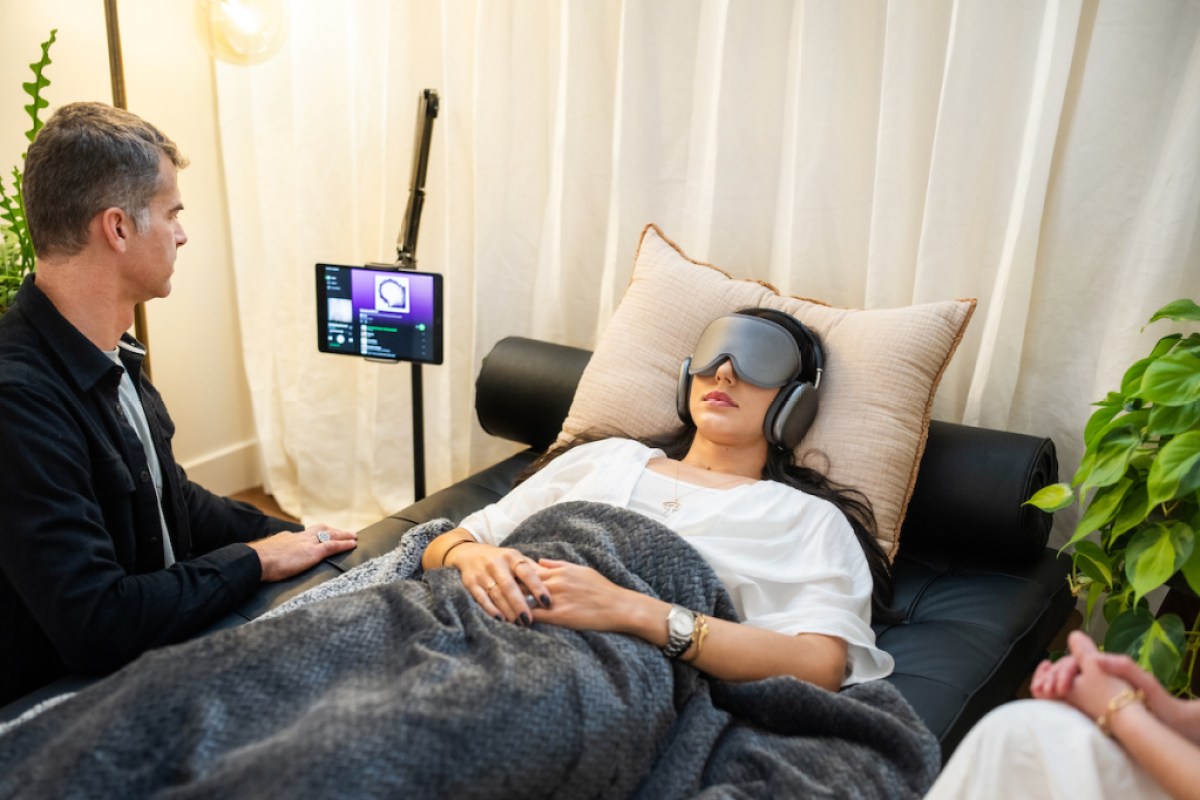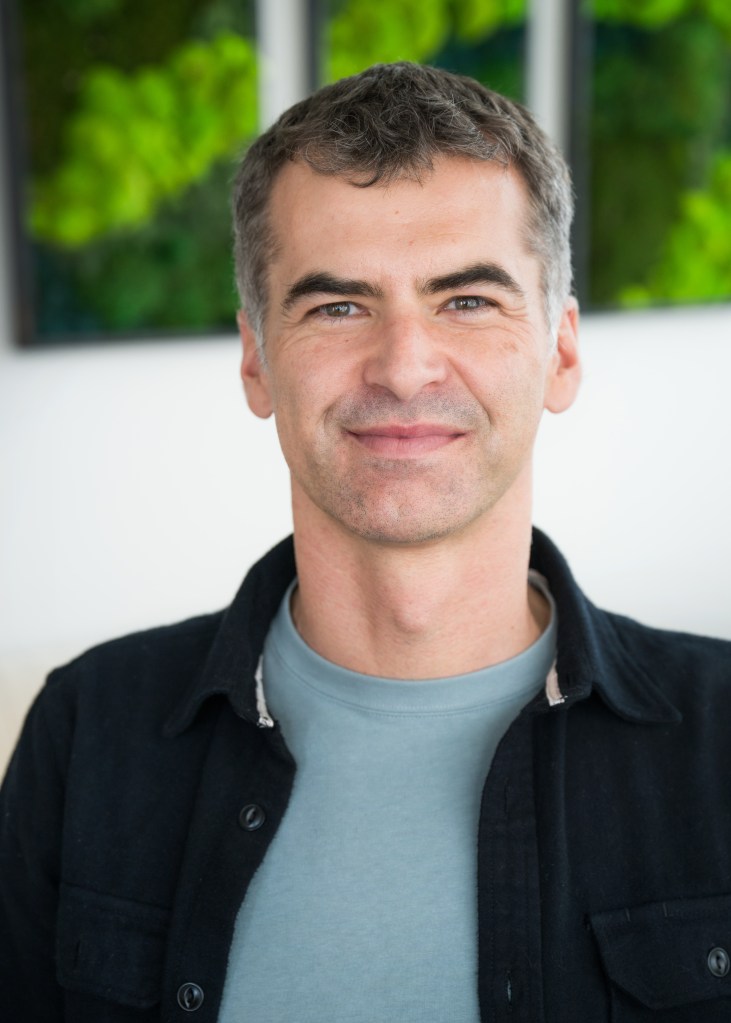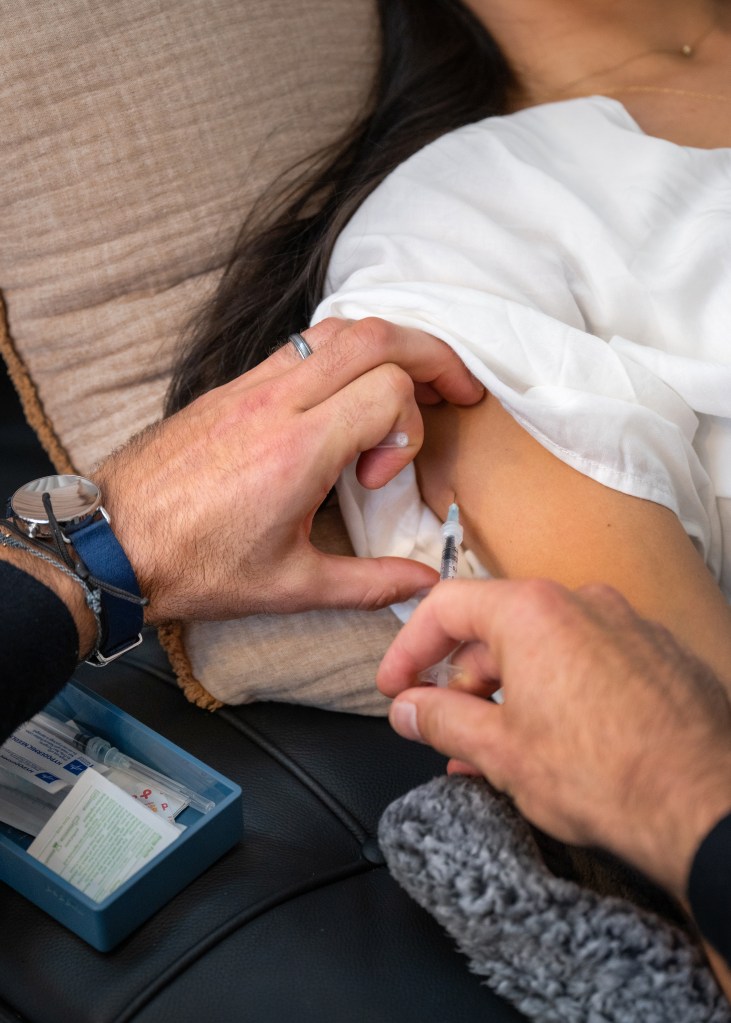Down the Rabbit Hole
Santa Barbara Independent Reporter
Takes a Trip into the World of
Ketamine Therapy
By Callie Fausey | May 9, 2024

“Do you want to try it out, or are you looking to see how deep the rabbit hole goes?”
Look, I know now that in Wonderland, I would be something of a clueless tourist. But when my ketamine guru, Dr. Remi Drozd, asked me that question, I feigned the confidence of someone who treats the rabbit hole as a bunny slope.
I gave it a generous five seconds of thought. “Put me somewhere in the middle,” I told him.
Psh, I remember thinking, how deep could the rabbit hole possibly go?
No, I had never done ketamine — an anesthetic and dissociative used on humans and animals, colloquially known as “horse tranquilizer” — but this was not my first hallucinogenic rodeo. And, this time, it was legal. Ketamine was given the FDA stamp of approval for hard-to-treat depression in 2019 and has since exploded into a huge, for-profit clinical industry. Based on its growing popularity in therapeutic settings, I thought I might lend myself as a guinea pig to share some insight into the experience.
While I made my snap decision in Drozd’s clinic, Lucid Therapeutics, I was lying in one of his cushy home-office-esque session rooms. As I watched him prepare the dose, I worried that it might even be too low for my promised therapeutic experience.

After sticking the needle in my arm, he reassured me that we could up the dose if needed. Then came a bougie eye mask and Apple headphones. The world went dark, my hands clammed up, and I did breathing exercises until the drugs kicked in a few minutes later.
Listen. I’m a writer. We exaggerate. But if that was “somewhere in the middle,” then holy crap. The rabbit hole must be pretty fucking deep.
One second, I was chilling and sipping peppermint tea in the real world, and the next, I was singing show tunes in La La Land.
At first, I felt like Alice, falling ass over teakettle into my delirium. But there were no playing cards or clocks in the rabbit hole — just a magnetic and disorienting pool of darkness. At one point, I sat up and ripped off the eye mask in a futile attempt to get a grip. Drozd had to gently calm and redirect me as if I were a delirious sleepwalker about to tumble down a flight of stairs.
I remembered what he said before we started: “You’re going to want to white-knuckle it,” he told me, “but you’re in a safe place. Let go and glide.”
Hesitantly, I loosened my grip on reality. I could feel my heart race and my chest rise and fall with every quickened breath, but at that moment, I became completely dissociated from my physical body.
Heart, lungs, tingly fingers … mine, yes. But me? No. Me was doing somersaults in a different dimension.
Eventually, in sync with the soothing, ethereal music playing through my headphones, I began climbing an invisible staircase. With each step, I reflected on glimpses of my life — my childhood, my relationships, my decisions. The scenes were like rolling clouds, bringing bursts of rain in between moments of sunlight. What would have normally been painful memories passed over my psyche like water off a duck’s back.
And when it felt like I was close to reentering the physical world, I would be hooked and reeled right back into the void.
I explored what my roommate (who picked me up from the clinic) jokingly called “the brain space.” It was endless and elastic and sticky. I jumped on a trampoline of neurons. I connected with the collective unconscious. I cried a little bit.
I started to come down about 45 or so minutes later. Drozd and I debriefed on the experience, and then I doodled about how I felt in my drowsy, third-eye-open state of mind.
I did the same before the experience as well. The prompt was simple enough: “Draw an image of who you are or what you are feeling.” Before I describe it, though, I think I should provide some context. Let’s rewind and start from the beginning.


[Click to enlarge] Left: The Lucid Therapeutics waiting room. Right: Drozd’s patients are encouraged to relax in the clinic’s lounge before and after the treatment for intention and reflection. Credit: Willa Kveta
My mental health first took a downturn when I was around 8 years old. My childhood was chaotic, which manifested in depression and anxiety, alongside other certain neurotic behaviors — an eating disorder, for one — to mimic a feeling of being in control. (Yeah, I’ve been to therapy.)
Through my upbringing, I learned how to mask my feelings. God forbid I — the middle child in a family funhouse of fucked-up — be a burden to anyone around me. Not to subject you to my pity party, but I “got over” many things on my own. Even so, it was like putting duct tape on a cracked windshield.
In college, I hit a very low point. Like, “just short of six feet under” low. That’s when I decided to seek help. At the risk of making it sound simple, I was able to get a better grip on my mental health, in part with the assistance of an antidepressant that mostly does its job.
Still, there are cracks: Dissociative feelings, days where I can’t get out of bed, traumatic memories that surface in nightmares, and mental spirals when things feel like they are just too much.
After stumbling into the world of psychedelic therapy for the Independent, I was curious to try it out for myself. If it helped other people, maybe it could help me too.
During my initial intake session with Drozd, we discussed my history of mental health struggles, treatments, and medications, as well as my physical health, to make sure the treatment was a good fit for me.
In the week leading up to the session, I was prescribed “looking out the window” and “taking deep breaths” every morning, combined with gratitude journaling and writing haikus about my feelings — things I’d normally write off as well-meaning but ultimately superficial mumbo-jumbo for rich hippies.

But I was committed to putting my all into this. The things I wrote about being grateful for were small and kind of stupid: stickers, blankets, the romaine and gorgonzola salad from South Coast Deli. However, to my surprise, it all helped me feel less dissociative and more in touch with my feelings. After a few days, I was kicking myself for my default skepticism. I was not quite as disgustingly optimistic as Julie Andrews in The Sound of Music, but ever so slightly closer to singing about my affinity for raindrops and kittens.
My week of breathing flew by, and before I knew it, it was time to get high. Walking into Lucid Therapeutics on Milpas Street, I was greeted by a comfortable, earth-toned waiting room and a kind receptionist, who asked me to take off my shoes and leave them by the door. I was wearing the Baby Yoda socks my old college roommate bought me at Disneyland. Admittedly, it had been a while since I did laundry.
We walked down a hallway lined with private rooms, and I was deposited in a breathable, curtained lounge area with plush pillows and cushions covering the floor. I immediately took note of the tissue box on the table in the center. It interrupted the kind of blasé amusement I had so far been feeling toward the whole experience. Damn, I thought, am I gonna cry? For the record, I hate crying.
There, I drew my first picture. It was a flower being nurtured by a rain cloud. The flower, of course, was me, losing petals. The rain cloud represents the challenges in my life — difficult experiences, sadness, anxiety, stress, etc. — which can be too much at times, but ultimately help me grow in moderation. The sun peeking out behind the cloud is the hope, positivity, and warmth that sticks around with an annoying persistence and keeps me going, helping me replenish what I lost along the way.
Deep. I know. But flowers are one of the only things I know how to draw.
After the treatment, I drew a completely different picture. Granted, I was still a little loopy. But when the worksheet asked who I was, I wrote “a web,” and when it asked me to draw a picture, I drew a bunch of little houses (representing different parts of myself) connected by some lines that — quite abstractly — represented a spider’s web.
The web was a symbol of how the treatment made me feel: more connected to myself and the world around me. If my head was the prison, then ketamine was the sharpened spork I could use to chisel my way out.
Since then, the dissociative episodes are fewer and farther between, and I have felt more in tune with my feelings. It planted my feet back on the ground. It’s like the song “Sweet Leaf” by Black Sabbath — “You introduced me to my mind,” sings Ozzy Osbourne — if you replace the weed references with ketamine. In other words, it did exactly what it was supposed to.


[Click to enlarge] Left: Callie’s pre-session drawing of “who she is.” Right: Callie’s post-session drawing. | Credit: Callie Fausey
Make a Mind Stretchy Again
Another Santa Barbara–based psychiatric nurse practitioner who specializes in ketamine-assisted therapy, Samantha Lau, explained that ketamine retrains and rewires the brain. Neuroplasticity makes it stretchy again, and patients can go in and kind of reorganize everything. She called it a “really robust antidepressant” best suited for people who are at the end of their rope and ready to dive deeper.
Lau herself found psychotherapy helpful after she developed PTSD from a break-in at her house. It helped her on her “healing path,” she said, allowing her to reestablish a “safety reference” and confront the neuroses driven by the fear instilled by the experience.

“There’s this witnessing effect; you experience it, and sometimes it can be very spiritual,” Lau said. “I think it — I call it a sacred space — helps people to allow a miracle to happen.”
Ketamine, she said, breaks down the mind’s defenses, to allow the patient to experience all the built-up, repressed stuff and feel the feelings their mind may have protected them from.
“It allows you to dissociate yourself from your day-to-day identity,” Lau explained, interrupting your mind from ruminating on anxious or depressive thoughts. “It gives you a different angle. So you have an opportunity to reframe who you are.”
Dani Martinelli, a patient of Lau’s, opened up to me about her experience. On the surface, her life seems perfect: a home in Carpinteria, professional success, and a loving family. “But the skeletons in the closet are mental-health issues that have disrupted every part of my life, from relationships to jobs to spiritual growth,” she shared.
She was in a place of desperation when she found Lau, having exhausted more conventional avenues for combatting depression and anxiety, including exercise, meditation, and medication.
Despite her best attempts, she wasn’t able to get out of the darkness. “I believe ketamine has just been one of those gifts, or tools, that is allowing me to rewrite my story,” added Martinelli.
Lau earned her trust quickly and made her feel held and guided — similar to how I felt with Dr. Drozd, who literally offered to hold my hand should I need it and who has routinely checked up on me since the treatment.
A good practitioner, Martinelli noted, is so important. The medicine opens a door, but it helps to have someone trustworthy — and legit — like Lau or Drozd to hold your hand during the journey.
When Martinelli started her journey, it was only up from there. After three sessions, she didn’t come back as the same version of herself. She had not expected to feel such a strong spiritual connection, either.
The treatment opened a gateway to accepting who she was — it scrambled her puzzle, and she was able to put the pieces back differently. She “time-traveled,” finding that she had nothing to prove. She had always felt the pressure for validation. The treatment opened her eyes: She does not have to prove her worth to anyone.
Before, she was in a crisis state. After, her battle with depression was not over — it’s not a quick fix — but she was given the gift of discovery, to peel back the layers, to know who she was.
“I mean, it’s one thing to go and have a treatment; it’s a whole ’nother thing to take what you have embodied or seen or felt and start asking some questions around it,” she explained.
People find wisdom, joy, and compassion in the experience, and then it’s up to them, perhaps with help from their therapist, to integrate it into their lives.
The main barrier to this treatment is access. Insurance doesn’t cover psychedelic therapies. And clinical experiences are expensive — usually ranging from $700 to $2,000. More affordable, at-home options are now available, but it helps to have a guide. Dr. Drozd, for one, is working with UC Santa Barbara’s insurance provider to help increase student access.
“It’s expensive, but when you think about the efficacy and the short amount of time that gets you from here to there, it’s a lot different than being in psychotherapy for two, three years,” Lau said.
Also, it’s definitely not for everyone. But Martinelli said something that resonated with me: “I think the uncertainty of what your journey is going to look like is better than the certainty that you’re going to wake up the next day depressed again.”
Depression has been normalized in our society, but it is a very real and very disruptive disease that manifests in different ways. Unfortunately, there is no cure-all. But it gives me some hope that the options for treatment are expanding. How one decides to treat their depression will look different on a case-by-case basis, but, to me at least, ketamine and other psychedelics — such as MDMA, which is on track for FDA approval — can be a valuable tool in advocating for happiness.
Quick Facts About Ketamine
- Ketamine is currently the only FDA-approved, legally available psychedelic drug. It can be obtained from medically certified persons, such as a psychiatrist or through online platforms, which require a consultation with a mental health care clinician. No prescription is needed.
- Ketamine therapy has been shown to result in significant decreases in depression, longer-term efficacy, and more immediate relief compared to antidepressants alone, according to a study published in the American Journal of Psychiatry.
- According to Dr. Remi Drozd, ketamine yields its greatest efficacy when administered deliberately across a series of three to 10 treatments. “While isolated treatments hold value, the enhanced healing potential lies in the continuum of ketamine-assisted therapy, particularly beneficial for individuals grappling with depression, anxiety, addiction, or trauma,” he says. It is not a silver bullet.
- Ketamine may not be suitable for everyone. Ketamine is not recommended for people with high blood pressure or seizure disorders and is generally not advised for those who have been diagnosed with psychosis or who have close family members with these conditions.
- Ketamine has the potential for misuse, based on its euphoric and dissociative effects, which, although uncommon in the U.S., can lead to physical and psychological dependence, according to American Addiction Centers.
- It is generally advised to never mix ketamine with other sedatives, or when doing strenuous exercise or operating heavy machinery.
- Anyone interested in ketamine therapy is advised to research whether it’s appropriate for their individual needs.




You must be logged in to post a comment.